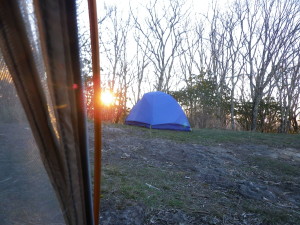For some spring break is just another date on the calendar or a memory of a seasonal vacation no longer observed. For many, however, it is a brief window of opportunity to get away or at least change the pace. How did you spend your spring break? Did you go to the beach and get a pre-summer tan? Did you don mouse ears and skip through the Magic Kingdom of Disney World? Did any of you stay home and work on your garden, planting tomatoes and peppers and such? I am sure many from our church here in Augusta found some time and opportunity to cross the bamboo boundary and watch some exciting golf.
While my two sons worked long hours related to The Masters and earned some “walking around” money, I spent my spring break walking along the Appalachian Trail (AT). My walking was more like huffing and puffing along a section of rolling mountains in the southwest North Carolina. The AT is a marked hiking trail in the eastern United States extending between Springer Mountain in Georgia and Mount Katahdin in Maine. It is approximately 2,181 miles long. I have hiked all of Georgia’s section and much of North Carolina’s part. In order to hike the entire trail, however, you will need more than a spring break because it will take about six months to cover the distance.
This is “thru-hike” season which means those desiring to hike the trail need to leave Georgia between March 15 and April 15 if they want to make it to Mt. Katahdin before Maine closes access on October 15. During my comparatively brief four days out there I met many thru-hikers. One guy was hiking nearly 20 miles per day, which is a brutal pace. That same day I met another couple that was more or less meandering at a snail’s pace of a just a few miles a day (I doubt they will make it). Most interesting of all among the thru hikers I met is that there is no “typical” hiker. I expected to see wiry and young college graduates choosing the trail before heading to corporate America, along with drop-outs trying to find themselves. There were other surprising encounters that defied my stereotype. I met a guy from England who had been on the trail for two weeks and he was at least 70 years old. The next day – after a harsh thunderstorm and spring freeze – I met three ladies easily in their sixties. Young and old; optimist and pouters; American and other – there were all kinds out on the AT with a common destination in mind.
God’s people are to be a diverse lot too. In the book of Acts we read that when the Holy Spirit came upon the early church the Christians spoke in languages from all over the world. It is a powerful symbol that the family of God is not monolithic; we do not all look alike but come from a rich and diverse tapestry. When the church begins to reflect the diversity of this earth we begin to “see” a better picture of the Kingdom of God. We are told in Acts: “In the last days it will be, God declares, that I will pour out my Spirit upon all flesh, and your sons and your daughters shall prophesy, and your young men shall see visions, and your old men shall dream dreams.” (2:17)
Look around you as we practice church each day and see for yourself God’s spirit at work. You will see a beautiful pallet of skin colors, languages, and social classes represented. No two are alike other than Christ died for all and Christ now lives for all. This journey to the cross and beyond is a journey where many are on the trail and while not a one of us is just like the other, we are all heading for the same destination, the same hope, the same Savior.
Thanks be to God for this indescribable gift! Amen.




Recent Comments